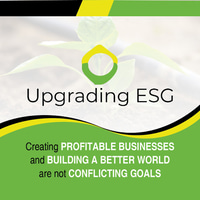The ESG Data Challenge
A deeper look at the challenges of ESG Data Management
Data collection is a major challenge. Most companies are not built to collect this data and requires a major change.
The Objective is that data extraction is automated and does not rely on manual processes in an integrated approach.
The end results of these solutions will save money, make your business more efficient, lower electricity and water usage and ESG data is sourced from many systems across your organisation, including ERP, HR, supply chain, and other operational systems, often in different standards and formats. The challenge is finding a solution that helps you connect, manage, and standardise your primary ESG data across all these systems so that you can reach your sustainability goals.
There is a need to:
· Integration with ERP / Accounting Systems– Utilities, Travel, Transport, Payroll info etc..
· Access data on supply chains - A wider approach Scope 3 - Policies,Procedures & Questionnaires
· With a focus on Compliance and verification ·
With a focus on supply chain
· Embedded Data Standardize framework KPIs
The vast amount of ESG data that’s collected from across your organization is in different formats, metrics, and units. Your chosen solution should convert all of the data collected into a common standard to meet the requirements for a consistent KPI framework.
Reporting of ESG is a major source of confusion. There are increasing legislation and there needs to be a clear standard. Areas of Interest
· Different Reporting NGOs
· Mandatory Reporting
· Verification, Audits & Transparency
· ESG Ratings
·Science-based Targets https://sciencebasedtargets.org/ ·
Science-based targets show organisations how much and how quickly they need to reduce their greenhouse gas (GHG) emissions to prevent the worst effects of climate change. ESG Reporting Challenges The multiple standards and frameworks have added to the complexity and challenges around ESG reporting. Organisations could be spending considerable time and effort to comply with the requirements across the different frameworks as stakeholders demand greater transparency. The proliferation of ESG reporting standards and frameworks, all with varying degrees of complexity, often leads to confusion around what to comply with. In addition, the definition of materiality for ESG is not akin to materiality in the financial reporting sense and drives the need for an ESG materiality assessment at the start of any ESG reporting initiative. Reporting on multiple frameworks can quickly become overwhelming for companies that do not have adequate resources. The absence of a dedicated ESG team could result in various aspects of ESG reporting being assigned to different functions within the organization. Inadequate controls, lack of proper governance structure and misaligned incentives could lead to disengaged stakeholders, poor data quality and a failure to institutionalize and scale the ESG disclosure process.
Another challenge is that the self-disclosed nature of the ESG reporting process could incentivize organizations to cherry-pick metrics and calculations. Such a strategy exposes such organisations to accusations of greenwashing from key stakeholders such as investors, customers and regulators, hurting their brand and exposing them to potential future legal risk. The options for ESG reporting and disclosures are myriad.
While not yet mandatory to report, it is only a matter of time1 Leaders need to get ahead of the curve now and prepare for the inevitable mandates.
So, Where do we start?
Quoting Bernard Jacobs .. the chief data detective at GCX, where advocates the bottom-up Data measurement approach “Currently, it is standard practice that organisations collect and report environmental data on a quarterly or annual basis and “verified” annually. [Can you imagine if accounting departments within the organisation did the same thing, there probably wouldn’t be a company].
After verification is complete, there is a scramble to prepare data for Annual Integrated Reporting and Respond to Regulatory and Voluntary Disclosures. Amongst other reasons, the main purpose of this exercise is to produce data and reports to help investors decide which organisations to invest in.
Whilst this has historically been enough, a simple high ESG rating no longer “cuts it”. Organisations now need to [with confidence] show improvement, introduce targets, and convince investors that they have a plan and it is working. The bottom line is, if you’re not PERFORMANCE MANAGING your non-financial and financial ESG data on [at least] a monthly basis like accountants do, then you’re probably not going meet your expectations and targets. ESG data is far more complex and far more reaching within an organisation than accounting data.
I am not saying that accounting data is easier or less important; it is probably because it is less understood. Over the past five years, I have, together with all the subject matter experts at GCX, developed an interactive dashboard that enables complete visibility into ESG data and performance. The combination of the GCX experts, the dashboard and our advisory services deliver the following for our clients.
1. Data Confidence
2. Improved Reporting
3. Saved Time and Money
4. Reduced Carbon Footprint
5. Provided one version of truth.
One final thought As a CFO, I have created an initiative called Upgrading ESG where I am offering a resource for companies. I truly believe the adoption of ESG by companies is an opportunity to improve efficiency and profit, help the environment and make your Company liked by Investors, staff and customers Please feel free to reach out to me at jeffrey@persofi.com to start or re-start your ESG Journey.
